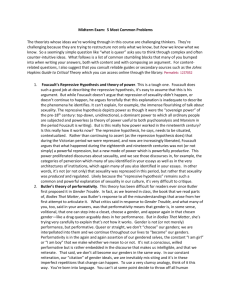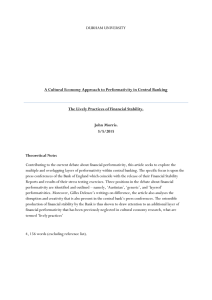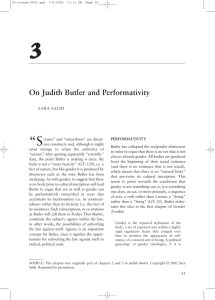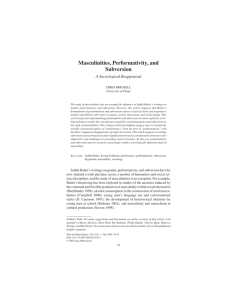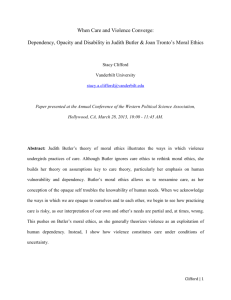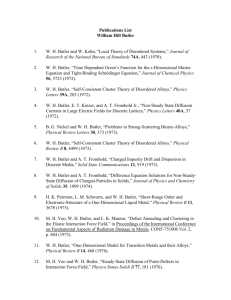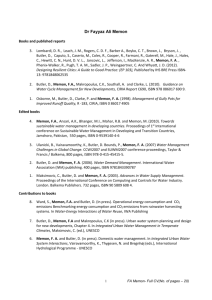Judith Butler and Performativity for Beginners (mostly in her own
advertisement
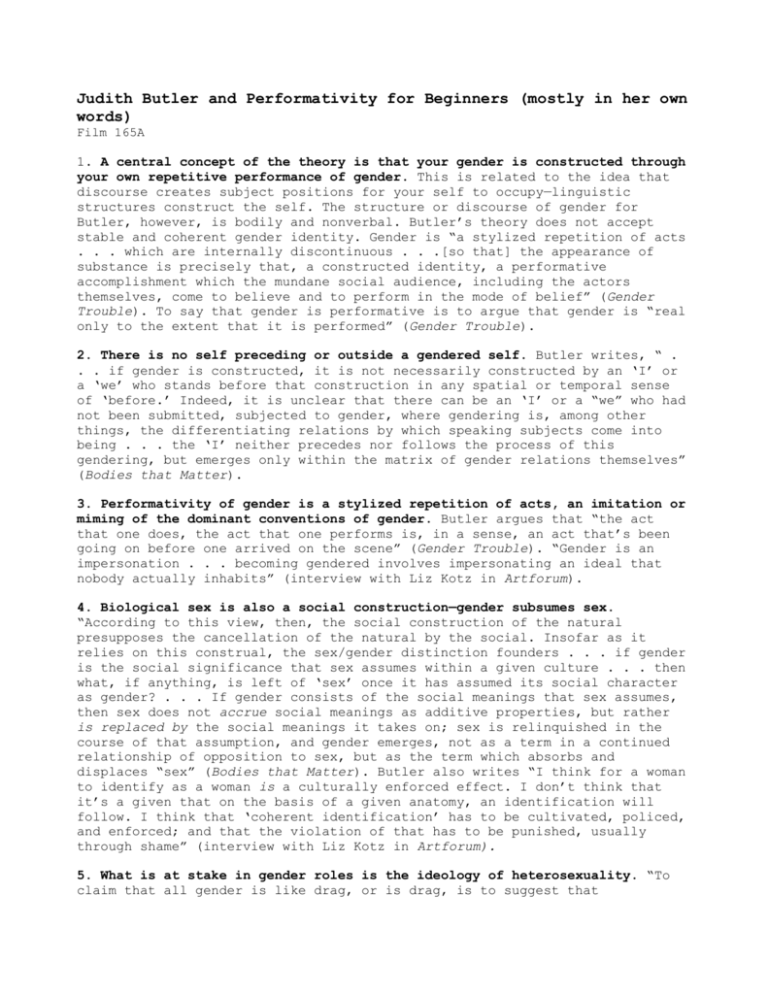
Judith Butler and Performativity for Beginners (mostly in her own words) Film 165A 1. A central concept of the theory is that your gender is constructed through your own repetitive performance of gender. This is related to the idea that discourse creates subject positions for your self to occupy—linguistic structures construct the self. The structure or discourse of gender for Butler, however, is bodily and nonverbal. Butler’s theory does not accept stable and coherent gender identity. Gender is “a stylized repetition of acts . . . which are internally discontinuous . . .[so that] the appearance of substance is precisely that, a constructed identity, a performative accomplishment which the mundane social audience, including the actors themselves, come to believe and to perform in the mode of belief” (Gender Trouble). To say that gender is performative is to argue that gender is “real only to the extent that it is performed” (Gender Trouble). 2. There is no self preceding or outside a gendered self. Butler writes, “ . . . if gender is constructed, it is not necessarily constructed by an ‘I’ or a ‘we’ who stands before that construction in any spatial or temporal sense of ‘before.’ Indeed, it is unclear that there can be an ‘I’ or a “we” who had not been submitted, subjected to gender, where gendering is, among other things, the differentiating relations by which speaking subjects come into being . . . the ‘I’ neither precedes nor follows the process of this gendering, but emerges only within the matrix of gender relations themselves” (Bodies that Matter). 3. Performativity of gender is a stylized repetition of acts, an imitation or miming of the dominant conventions of gender. Butler argues that “the act that one does, the act that one performs is, in a sense, an act that’s been going on before one arrived on the scene” (Gender Trouble). “Gender is an impersonation . . . becoming gendered involves impersonating an ideal that nobody actually inhabits” (interview with Liz Kotz in Artforum). 4. Biological sex is also a social construction—gender subsumes sex. “According to this view, then, the social construction of the natural presupposes the cancellation of the natural by the social. Insofar as it relies on this construal, the sex/gender distinction founders . . . if gender is the social significance that sex assumes within a given culture . . . then what, if anything, is left of ‘sex’ once it has assumed its social character as gender? . . . If gender consists of the social meanings that sex assumes, then sex does not accrue social meanings as additive properties, but rather is replaced by the social meanings it takes on; sex is relinquished in the course of that assumption, and gender emerges, not as a term in a continued relationship of opposition to sex, but as the term which absorbs and displaces “sex” (Bodies that Matter). Butler also writes “I think for a woman to identify as a woman is a culturally enforced effect. I don’t think that it’s a given that on the basis of a given anatomy, an identification will follow. I think that ‘coherent identification’ has to be cultivated, policed, and enforced; and that the violation of that has to be punished, usually through shame” (interview with Liz Kotz in Artforum). 5. What is at stake in gender roles is the ideology of heterosexuality. “To claim that all gender is like drag, or is drag, is to suggest that ‘imitation’ is at the heart of the heterosexual project and its gender binarism, that drag is not a secondary imitation that presupposes a prior and original gender, but that hegemonic heterosexuality is itself a constant and repeated effort to imitate its own idealizations. That it must repeat this imitation, that it sets up pathologizing practices and normalizing sciences in order to produce and consecrate its own claim on originality and propriety, suggests that heterosexual performativity is beset by an anxiety that it can never fully overcome….that its effort to become its own idealizations can never be finally or fully achieved, and that it is constantly haunted by that domain of sexual possibility that must be excluded for heterosexualized gender to produce itself” (Bodies that Matter). 6. Performativity of Gender (drag) can be subversive. “Drag is subversive to the extent that it reflects on the imitative structure by which hegemonic gender is itself produced and disputes heterosexuality’s claim on naturalness and originality” (Bodies that Matter). 7. But subversion through performance isn’t automatic or easy. Indeed, Butler complains that people have misread her book Gender Trouble. “The bad reading goes something like this: I can get up in the morning, look in my closet, and decide which gender I want to be today. I can take out a piece of clothing and change my gender, stylize it, and then that evening I can change it again and be something radically other, so that what you get is something like the comodification of gender, and the understanding of taking on a gender as a kind of consumerism. . . . [treating] gender deliberately, as if it’s an object out there, when my whole point was that the very formation of subjects, the very formation of persons, presupposes gender in a certain way— that gender is not to be chosen and that ‘performativity’ is not radical choice and its not voluntarism . . . Performativity has to do with repetition, very often the repetition of oppressive and painful gender norms . . . This is not freedom, but a question of how to work the trap that one is inevitably in” (interview with Liz Kotz in Artforum). Butler also writes that “it seems to me that there is no easy way to know whether something is subversive. Subversiveness is not something that can be gauged or calculated . . . I do think that for a copy to be subversive of heterosexual hegemony it has to both mime and displace its conventions” (interview with Liz Kotz in Artforum).
![Challenging the Mechanistic within Research Methodologies - Using Butler to Work both 'Within and Against Interpretivism' [PPTX 3.71MB]](http://s2.studylib.net/store/data/015030227_1-3c5b0820d01d9ff36fbf237764c56d40-300x300.png)

